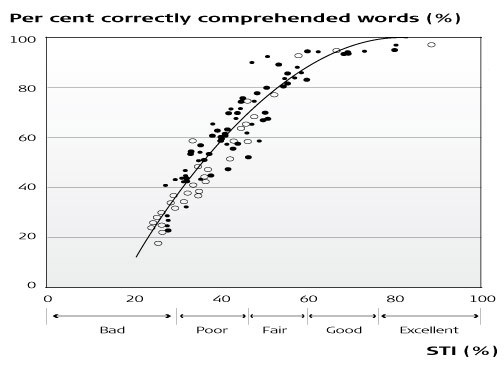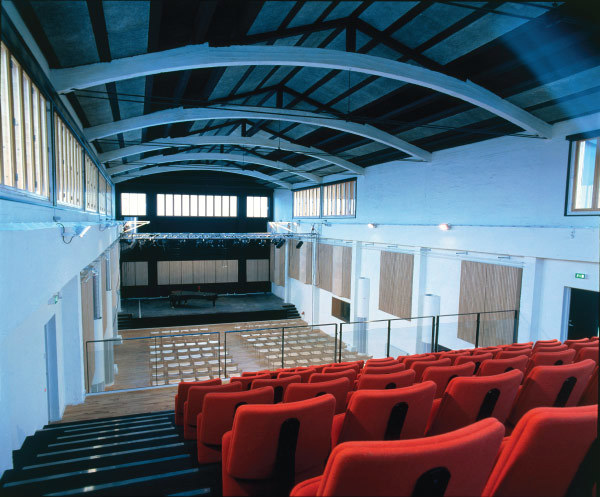Speech intelligibility and speech intelligibility goals
- The term speech intelligibility indicates in per cent how many words are correctly comprehended by listeners in a room when an articulate speaker reads a text – either directly or via a sound system.
- With the Speech Transmission Index (STI) method, using a special apparatus it is possible to measure how good the speech intelligibility is in a room. The result will lie between 0 (0 per cent) and 1 (100 per cent). A typical requirement for a room is an STI value above 0.6.
- STIPA is a variant specially designed to measure a sound system. The measurement takes place by sending out a special sound signal through the sound system and using a specially adapted sound meter. A STIPA above 0.6 means that the sound system delivers a satisfactory sound quality.
This section introduces the concept of speech intelligibility, which indicates how well we perceive the spoken word in a given room. This is an important quality factor – not least in rooms which are intended for communication. In addition, the section introduces the measuring methods which can ensure good speech intelligibility, especially in situations where there is a sound system in the chain between speaker and listener.
It is important how well we perceive the spoken word in a given room. Not least in rooms designed for communication such as auditoria and theatres – or even railway stations.
In terms of acoustics, speech intelligibility is a well-defined concept which indicates how well speech is perceived in a room – either directly with a speaker and a number of listeners, or via a sound system with a microphone, amplifier and speaker(s). Traditionally, speech intelligibility has simply been measured by listing how many words listeners have heard correctly in a text which is read out loud by an articulate speaker in the room in question. If the listeners, for example, hear 60 per cent of the words correctly, the speech intelligibility is 60 per cent or 0.6. Speech intelligibility as a concept was created in the early days of telephony in the 1920s in order to establish a target for telephone quality. It is not hard to imagine that this process can be very time-consuming, and therefore considerable efforts have been made over the years to calculate or directly measure speech intelligibility in a given situation, both in a real room such as a lecture hall, or via a PA system, for example at a railway station.
Today, there are several methods for measuring speech intelligibility, but the method which is now regarded as the standard approach is the so-called Speech Transmission Index (STI). The STI is an objective measurement and calculation method that includes a number of parameters about the actual space, according to which it is then possible to calculate the speech intelligibility that can be achieved in the given circumstances.
Likewise, STI enables clients to specify requirements for speech intelligibility in, for example, a classroom, thereby ensuring that the quality in this respect is satisfactory once the project is finished. STI is measured using special calibrated devices, and the measured value can be compared directly with the specified requirements. The STI value lies between 0 and 1 (or between 0 and 100 per cent), where 0 indicates completely unacceptable and poor speech intelligibility, while 1 indicates perfect conditions. The requirement for the STI value will depend on the actual conditions, but the typical requirement for speech intelligibility will usually be an STI value higher than 0.6. This will normally ensure satisfactory speech intelligibility.
Figure 17: Speech intelligibility as a function of STI, Speech Transmission Index

The method can also be used in cases where there is a PA system in the ‘chain’ between the speaker and the listener. In this situation, speech intelligibility results from the total effect of the room and the sound system. A very good sound system will thus be no guarantee of good speech intelligibility if the room has a long reverberation time when the listener is sitting a long way from the speaker. Here, you are able to make requirements for speech intelligibility, for example in the form of an STI value for the entire chain comprising the PA system and the room. It is then the responsibility of the system supplier or the sound designer to ensure that the requirements are met by the final system in the room in question. In this way, the client can ensure that the final solution is satisfactory and functional. An experienced sound designer can use the calculations to ensure that his system has a reasonable chance of delivering the required results in the room in question.

Photo: While respecting the character of the existing buildings, the acoustic requirements were taken into account during the refurbishment of the Danish National School of Performing Arts, the Royal Danish Academy of Fine Arts Schools of Architecture, Design and Conservation, the Rhythmic Music Conservatory and the National Film School on Holmen in central Copenhagen.
It may be that the room’s acoustics are unsuitable for a PA system, and that efforts should be made to improve them first, as a PA system cannot rectify poor acoustics. If you are installing a sound system (a PA system) in a room, there is a simplified method for measuring speech intelligibility – STIPA. With STIPA, a special measuring signal is used which is played through the sound system. By using a special sound meter, it is possible to measure the STIPA value of the complete system and the space at the location. A STIPA value above 0.6 indicates a good system. It should be mentioned that other speech intelligibility measures which have been used over the years, for example AI (Articulation Index), ALCONS (Articulation Loss of Consonants) and RASTI (Rapid Speed Transmission Index), are today all considered as being out of date.
